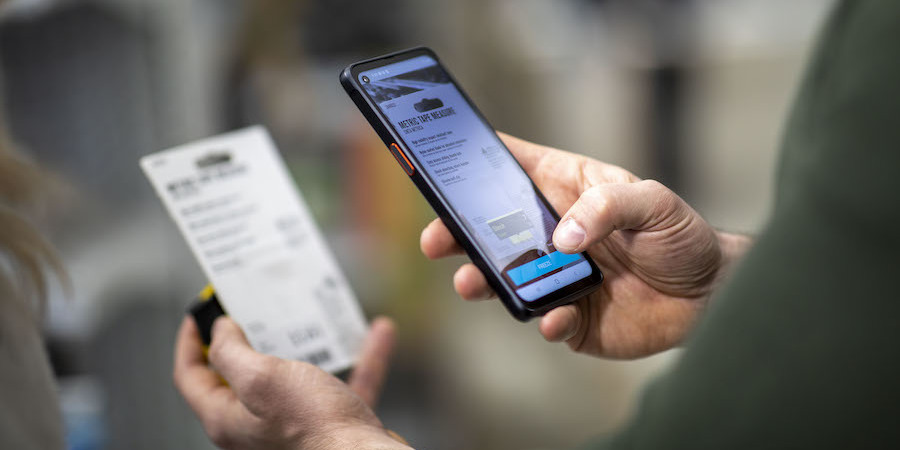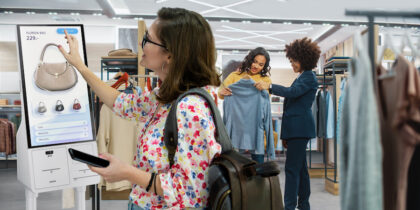Since a pack of Wrigley’s Gum first passed over a scanner in a Marsh supermarket in Troy, Ohio, in 1974, retailers have relied on scanning and barcodes for inventory management. But for decades the high cost of scanners limited its applications — until Scandit came along to change the game.
Using an artful blend of proprietary computer vision, augmented reality (AR) and machine learning (ML) technologies, the 10-year-old Swiss firm has brought scanning to the masses by enabling smartphones to scan as well or better than a dedicated barcode scanner. That allows retailers to expand their view of inventory exponentially, while also transforming how stores operate via smartphone apps. Now, retailers can afford to equip every associate with an inventory management device, just in time to meet today’s elevated consumer demands.
Modernizing Retail Scanning
Scandit was founded in 2009 by a group of researchers from MIT, ETH Zurich and IBM Research, and has evolved into a world-class team of mobile image processing, cloud-computing and internet of things (IoT) experts from around the globe. The company’s culture of thought leadership and innovation is built around breaking new ground in mobile data collection through digital interactions with everyday objects.
While some companies add scanning to smartphones via sleds, Scandit devised an entirely software-based way to scan via smart mobile devices using the built-in camera functionality. That integration lowers the cost of scanning even more than a sled does, by significantly minimizing acquisition, maintenance and support costs.
By downloading Scandit-enabled software, every associate can now reliably and efficiently capture barcodes and text throughout the store via an easy-to-manage fleet of smart devices. That enables retailers to capture data on inventory status much more often, at many more points throughout the retail supply chain and the store floor.
Smart inventory management also translates into better customer experiences. When an associate is confident in the tool and the information it delivers, they are more likely to help the customer effectively. Effective assistance improves the bottom line, as indicated by a TimeTrade study that found that 94 percent of consumers tend to buy more when they have live interactions with a knowledgeable employee.
How Smart Device-Based Scanning Works
Scandit mobile computer vision software scans any barcode and recognizes text via a smartphone or tablet’s built-in camera feed, no matter what the conditions are, and at industry-leading speeds and distances. At the core of the Scandit platform is a powerful data capture engine that combines a wide range of leading-edge mobile computer vision technologies such as barcode scanning and optical character recognition.
How Mature Is Your In-Store Mobility?
Evaluate your retail mobile initiative to learn how it can better support great customer experiences. Download Now
A set of powerful cloud services enables efficient analysis of the captured data. Retailers can add these solutions to existing IT infrastructure and synchronize enterprise data with enterprise resource planning (ERP) and e-commerce software via Scandit’s versatile integration layer. Options include a software development kit (SDK) or turnkey Scandit scanning apps.
Retailers are leveraging these capabilities across their operations. Use cases include associate-facing functions, such as order picking, shelf management, cycle counting and inventory location, as well as customer-facing uses, including clienteling and AR-enabled product information lookup.
Next-Gen Inventory Management
Scandit has also developed MatrixScan, which promises to take inventory management in retail to the next level. MatrixScan enables smart devices to locate, track and decode multiple barcodes at once. This means a retail associate can point a smart device at an entire shelf or pallet of goods and capture all of the barcodes in a single sequence. Intelligent software can then identify the correct item or location, significantly speeding up store processes like picking items for a click and collect order.
MatrixScan also enables users to overlay relevant product information in real time using AR and superimpose it on the screen of a user’s smart device. Retailers will be able to use this capability to compare items on a shelf to expected inventory, for example, or share important features to a customer they are helping.
A Powerful Partnership
By combining Scandit’s powerful data capture engine and Samsung’s field-ready smartphones and tablets, retailers gain access to a cost-effective way to transform store activity without the need for two separate devices. With a mobile device in every associate’s hands, retailers can impact every aspect of store operations, from human resources, scheduling, training and employee communications to clienteling, fulfillment, point of sale (POS) and inventory management.
Samsung’s enterprise-ready products and services make that possible. In addition to a broad range of mobile devices at every price point, including new rugged options such as the Galaxy XCover Pro and Galaxy Tab Active Pro, Samsung offers deep retail industry knowledge and commitment to customer success, as well as its Knox platform and services to easily secure, configure, manage and support devices.
Thanks to the strong ongoing partnership of Scandit and Samsung, businesses not only get the game-changing benefits of having a scanner in every associate’s hands; they also gain early access to next-gen capabilities like MatrixScan as they are introduced. That means they can continually enhance visibility and control over their largest asset — their inventory — to drive their businesses forward.
Learn more about the paperless workflow solutions that keep your business stay ahead of the curve. Improve your retail associate performance with data and mobile devices by following this free guide.








